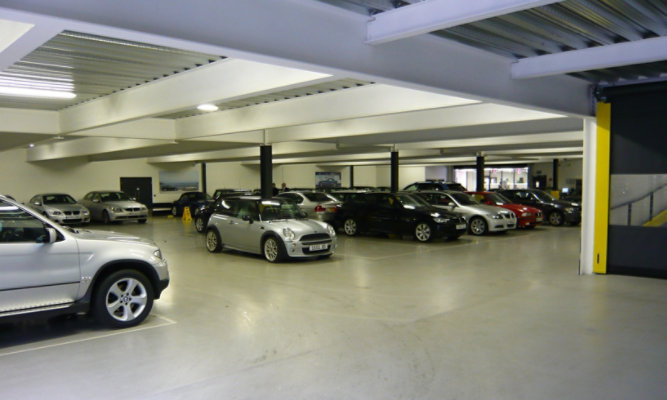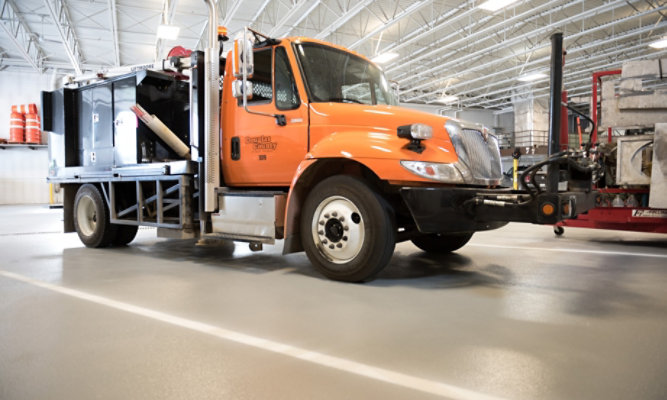
Why Is My Epoxy Floor Bubbly or Gummy the Next Day?
Tips for Avoiding Bubbly or Gummy Epoxy Flooring
When it comes to using two-part epoxy paint and resin systems, several issues can potentially occur if the project is not properly planned. We will go over two of the more common issues that may occur, and offer solutions on how to prevent them for the most professional job possible. Remember, it’s essential to read all product technical data and installation instructions in their entirety before beginning any project.
Learn More or Get a Free Flooring Evaluation
Issue: Bubbles in Cured Coating
Bubbles (or craters that result from popped bubbles) can be up to 2 centimeters in diameter or as small as a pinhead. Whether they appear in clusters or throughout the entire coating, the cause is always the same: trapped air. This air entrapment may be the result of a number of factors, including:
Concrete Outgassing
- All concrete is porous, but depending upon its composition and condition, some slabs have more microscopic pockets of air than others. Evidence of the air being released from the slab, aka outgassing, is seen after the floor is properly mechanically prepared and “opened up.” After a coating is applied and begins to cure, the trapped air can begin to heat up and expand.
- Preventative Measure: Prime porous concrete with a low viscosity, fast-curing, penetrating primer. Occasionally, more than one primer coat may be needed.
Incorrect Mixing Technique
- Mixing components at super high speed can cause air to become trapped in the liquid coating.
- Preventative Measure: Use a drill speed of 100-300 rpm for best results. Move the mixing blade in circles from the outer edge of the container to the inner edge.
Inadequate Roller Covers
- The quality of the tool determines the quality of the job. A fiber roller cover with a nap that is too dense or too sparse can also introduce air to the coating, resulting in bubbles.
- Preventative Measure: Avoid rolling too aggressively or quickly. Use long strokes and even pressure. Look for a high quality, short nap, lint-free roller and remove excess product before rolling.
Repairing Bubbles in Floor Coatings
Using a rotary disc scrubber with 60-80 grit sandpaper, remove bubbles, ridges and protrusions, vacuum up all dust and use Xylene or Xylol to wipe the surface thoroughly. Recoat the floor at a rate of 150 square feet per gallon of product if manufacturer’s tech data allows. Always feather the edge of any imperfections. Depending on the severity of the bubbles, one may have to first use a thixotropic patching material and then re-sand certain areas before recoating. For extremely porous slabs, additional coats of primer may be needed before the finish coat(s) can be applied.
Issue: Cured Coating is Soft or Gooey
When the 24-hour cure time has passed and the epoxy coating is tacky, has not hardened in spots, or does not have the high-gloss, durable surface expected, examine the following factors.
Gooey or Messy Coating
This typically happens when the person in charge of the mixing station adds an incorrect amount of the Part B catalyst to a two-component system—or forgets to add Part B altogether.
Sticky Areas in Cured Coating
Tacky spots are usually the result of improperly mixed liquids. Either the individual used an improper ratio of Parts A & B or did not mix thoroughly enough. Another way small areas of the floor remain sticky is when a mixing bucket is turned over and left on the floor to empty out. Unblended components on the sides of the container will drip down onto the floor, causing the area to cure improperly.
Uniform Surface that Resists Hardening
A slightly soft but otherwise even surface is usually the result of curing in temperatures that are too cold. However, the possibility of an incorrect mix ratio cannot be discounted.
Repairing Gummy Flooring
Before beginning, mark the spots that need repair so as to not waste time and materials repairing the entire surface if it is not necessary.
If it is determined that the problem was caused by an error in mixing, use a scraper or mechanized tool to scrape away the uncured coating. Most likely a strong solvent (Xylene or Xylol) will be needed to thoroughly clean the concrete surface and remove any particles that may be left behind. Re-prep, patch and reinstall as needed. Note that the patched areas will not always seamlessly blend, so the floor may require another complete topcoat to achieve a uniform look.
Flooring Solutions for Any Facility
At Sherwin-Williams, thanks to our network of highly experienced approved local installers and regional technical representatives, errors like those described above are rare indeed! Our professionals work with facility managers to provide the optimal flooring solution for their unique operational needs—and their budget. With these outstanding solutions, we have the polymer flooring systems hard-working facilities need. To learn more, contact us today—we look forward to solving your flooring challenges.
Discover More
Industry Expertise and Innovation
See how we help customers find customized solutions for their project and application challenges.
System Lookup
Find out more about our innovative floor systems for a variety of industries.
FIND A SYSTEM

